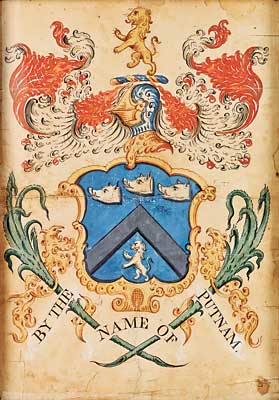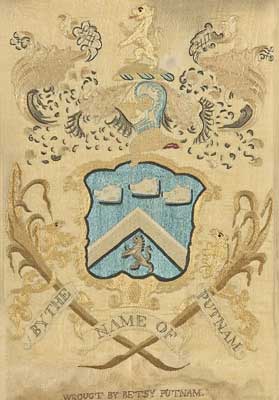 |
| Home | Articles | Winterthur Primer: X-Radiography Examination of an Embroidered Coat of Arms |
|
|
 |
|
by Angela Duckwall
|
 |
 |
 |
Fig. 1: Coat of arms embroidery, likely from Boston, Massachusetts, ca. 1790–1820, embroiderer unknown. 1964.0617.
|
In the last half of the eighteenth century, wealthy New England schoolgirls often displayed their stitching skills by executing elaborately embroidered coats of arms.1 One such object (Fig. 1), likely from Boston and dated between 1790 and 1820, is now in the collection of Winterthur Museum. Much of the surface is elaborately embroidered, but in one location the word “Gold” has been written on the silk ground fabric, partially obscured between the worked shield and garlands (Fig. 2). This presented the distinct possibility that the wording was intended as a color instruction for the embroiderer and was provided by the artist who painted the design. Research suggests that the designs for coats of arms used by schoolgirls were typically chosen from books of heraldry and then a sign painter or artist was employed to reproduce and transfer them to the fabric using paint.2 The presence of the word “Gold” was exciting given that little is known about how the color instruction was relayed to the embroiderer when a design was purchased.
|
 |
 |
 |
Fig. 2: The word “Gold” is written on the front of the coat of arms embroidery, beneath the shield.
|
X-radiography provided valuable information about the materials used in the embroidery and how it may have been made. Most commonly used in the medical field to diagnose things like broken bones, in conservation, x-radiography is often used to examine items with complex construction. An x-radiograph captures objects by density rather than what the naked eye can see. When an x-radiograph is taken, the result is an image in shades of black, white, and grey that captures not only what lies on the surface but often what is otherwise hidden beneath. The white areas pinpoint the densest materials in the object, the black areas, the least dense; and so such things as a nail hidden in the interior of furniture or repairs in sculpture may become visible. Using x-radiography to examine textiles is a relatively new application of the process. Recent research has shown it to be useful when trying to determine hidden elements of stitching techniques and object construction.3
|
 |
 |
Fig. 3-1: Watercolor of Putnam coat of arms. 1955.83.4.
|
Fig. 3-2: The embroidered Putnam coat of arms, attributed to Sally Putnam. 1955.83.3.
|
|
|
|
 |
Fig. 4: Assembled x-radiographs of the embroidery. The metal threads show up brightest, followed by the underdrawing, and even the silk threads can be seen.
|
 |
 |
 |
Fig. 5: Color directions in the underdrawing. Also seen here as a grey rectangle is a stabilization fabric patch behind the metal stitching of the wreath element.
|
For a dark fabric like that seen in figure 1 the paint used was most likely a combination of lead white and gum water.4 Since this paint was much denser than the embroidered threads that covered it, an x-radiograph might reveal if there were any words written on the original design. In some cases, a print or watercolor of the same design might have been used as a guide. This appears to be the case for another coat of arms in the Winterthur collection, embroidered by Sally Putnam, which has a corresponding watercolor, presumably used for color instruction (Fig. 3).5
The x-radiographs did indeed reveal drawing on the fabric, which had both a design and color directions (Figs. 4, 5). The color directions were given throughout in complete words and single letters, such as “white,” “red,” “W,” and “R.” The “Gold” was seemingly an instruction for the shield, garlands, or background area on which the writing was placed.
|
 |
 |
 |
Fig. 6: Bright white lines showing metal foil strips woven into the selvedge of the ground fabric.
|
The x-radiographs also revealed thin metal strips woven into the selvedges that had, until this point, been interpreted as brown yarns (Fig. 6). Further elemental analysis using x-ray fluorescence (XRF) indicated that these strips contain copper and zinc, which identifies them as most likely brass. It is not known exactly what they signify, but in fifteenth-century Italy, similar techniques were used to indicate where a cloth was woven, its grade, or its dyestuff.6 These strips may be evidence of an extension of this practice into the late eighteenth century.
X-radiography answered the questions about color instruction on the fabric by revealing the underdrawing. It also raised new questions about the selvedge and cloth weaving in the eighteenth century. Both results have helped to extend our knowledge of textile history and would not have been possible in a safe manner without x-radiography.
|
|
 |
All images courtesy of Winterthur Museum.
|
|
 |
Angela Duckwall is a Fellow in the Winterthur/University of Delaware Program in Art Conservation (WUDPAC). She wishes to thank Joelle Wickens, Winterthur’s assistant textile conservator and adjunct assistant professor for WUDPAC; Joe Weber, associate professor for WUDPAC; and Joy Gardiner, Winterthur’s textile conservator, assistant director of conservation, and adjunct professor for WUDPAC, for all of their support and guidance during this project.
|
|
 |
1. Betty Ring, “Heraldic embroidery in eighteenth-century Boston,” Antiques, 141 (April 1992), 622–631.
2. Betty Ring, Girlhood Embroidery: American Samplers & Pictorial Needlework., 1650–1850 (New York: Knopf, 1993).
3. Sonia O’Connor and Mary Brooks, X-Radiography of Textiles, Dress and Related Objects (Boston: Elsevier/Butterworth-Heinemann, 2007).
4. Lynne Bassett. “Jerusha Pitkin’s Embroidered Coat of Arms,” PieceWork (May/June 2002): 50–54.
5. A. S. Dorsey Buchbinder and L. Eaton. Who’s Your Daddy?: Families in Early American Needlework. Exhibit catalog, October 4, 2008–August 17,2009, Winterthur Museum and Country Estate, Winterthur, DE.
6. L. Monnas, “Loom Widths and Selvedges Prescribed by Italian Silk Weaving Statutes 1265–1512: A Preliminary Investigation,” CIETA Bulletin 66 (1988): 35–44.
|
|
    |
|
 Download the Complete Article in PDF Format Download the Complete Article in PDF Format    Get Adobe Acrobat Reader Get Adobe Acrobat Reader
|
|

|
 |
 |
|
|